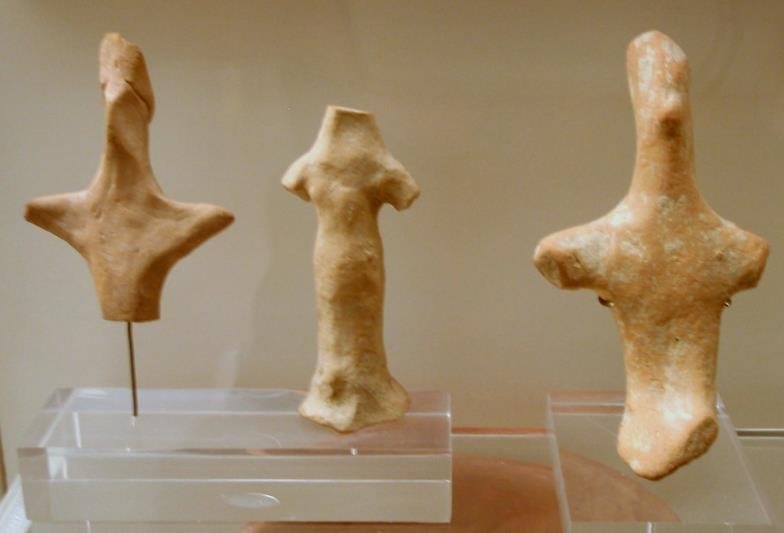Ancient fingerprints discovered on terracotta figurines from Thonis-Heracleion shed light on the diverse group of artisans, including men, women, and children, who crafted these artifacts centuries ago.
Unveiling the Makers of Terracotta Figurines
A groundbreaking study by Leonie Hoff, a Ph.D. student at the University of Oxford, has revealed the identities of the artisans behind ancient Egyptian terracotta figurines. Using Reflectance Transformation Imaging (RTI) technology, Hoff analyzed fingerprints found on nine well-preserved figurines dating back to the Late and Ptolemaic periods (7th-2nd centuries BC). This marks only the second attempt to study ancient Egyptian fingerprint impressions, offering unprecedented insights into the organization of labor during that era.
The figurines, excavated from the submerged port city of Thonis-Heracleion in the 1990s, provide a rare glimpse into the lives of the workers who shaped these intricate pieces. Traditionally, historians and archaeologists struggled to identify the creators due to the nature of the materials used. Nile silt, the primary medium for these figurines, was not conducive to detailed work, making the presence of fingerprints an unexpected find.

Technological Advancements in Archaeology
The application of RTI technology has revolutionized the way researchers study ancient artifacts. By capturing the surface details of the terracotta figurines, Hoff was able to extract and analyze the fingerprint patterns. This non-invasive method preserves the integrity of the artifacts while providing valuable data that was previously inaccessible.
Benefits of Reflectance Transformation Imaging:
- Non-destructive Analysis: Preserves the original state of the artifacts.
- Enhanced Detail Recognition: Reveals minute surface features not visible to the naked eye.
- Data Preservation: Creates a digital record for future research and analysis.
Hoff’s methodology builds upon the initial study published in the Oxford Journal of Archaeology, which first demonstrated the feasibility of using RTI to study ancient fingerprints. The success of this approach in identifying the sex and age of the craftsmen marks a significant milestone in archaeological research.
Insights into Labor Organization
The fingerprints suggest a varied workforce, including adults and children, challenging previous notions about labor distribution in ancient Egypt. This diversity indicates a more complex and organized system of production than previously understood.
- Men: Likely responsible for the bulk of the heavy labor and foundational work.
- Women: Possibly engaged in detailed finishing touches and decorative aspects.
- Children: May have assisted in simpler tasks, learning the craft from a young age.
This collaborative effort highlights the importance of family and community in ancient Egyptian craftsmanship. The involvement of different age groups and genders suggests that figurine production was a communal activity, integral to both economic and social structures.
Economic and Cultural Implications
Understanding the workforce behind terracotta figurines provides deeper insights into the economic and cultural dynamics of ancient Egypt. The ability to produce detailed figurines in line with Greek production techniques reflects a blend of indigenous and foreign influences, particularly after the Greeks arrived in Egypt in the 7th century BC.
Key Implications:
- Economic Growth: The production of figurines likely contributed to local economies, providing livelihoods for artisans and their families.
- Cultural Exchange: The refinement of techniques under Greek influence indicates a period of cultural exchange and adaptation.
- Technological Innovation: The use of RTI technology represents a modern advancement that bridges past and present, enhancing our understanding of ancient societies.
The meticulous craftsmanship of the figurines underscores the value placed on artistry and religious expression in ancient Egypt. These artifacts were not merely decorative but held significant cultural and possibly ritualistic importance.
Future Research Directions
Hoff’s study opens the door for further research into ancient labor practices and craftsmanship. Future studies could expand the sample size of figurines analyzed, explore other archaeological sites, and refine the techniques used to extract and interpret fingerprint data.
Potential Research Avenues:
- Broader Geographic Scope: Analyzing artifacts from different regions of Egypt to compare labor organization.
- Interdisciplinary Approaches: Combining RTI with other technologies like 3D scanning and chemical analysis for comprehensive studies.
- Historical Contextualization: Integrating fingerprint data with historical records to create a more detailed picture of ancient Egyptian society.
This pioneering research not only enhances our understanding of ancient Egyptian craftsmanship but also showcases the potential of modern technology in uncovering the secrets of the past.
Collaborative Efforts in Archaeology
The success of Hoff’s study underscores the importance of collaboration between technologists and archaeologists. By leveraging advanced imaging techniques, researchers can uncover details that were previously hidden, leading to more nuanced and accurate historical interpretations.
- Interdisciplinary Collaboration: Combining expertise from different fields to advance archaeological research.
- Technological Integration: Utilizing cutting-edge tools to enhance traditional methods of analysis.
- Global Partnerships: Engaging with international scholars and institutions to broaden the scope and impact of research findings.
Such collaborations are essential for pushing the boundaries of what we know about ancient civilizations and ensuring that our interpretations are both accurate and comprehensive.
Public Engagement and Education
Discoveries like these have significant implications for public engagement and education. By making ancient history more tangible and relatable, researchers can foster a deeper appreciation for the complexities of past societies.
Educational Benefits:
- Enhanced Learning Materials: Incorporating recent discoveries into educational curricula.
- Public Exhibitions: Showcasing artifacts and research findings in museums and public spaces.
- Community Outreach: Engaging the public through lectures, workshops, and interactive programs.
Bringing the stories of ancient artisans to life helps bridge the gap between past and present, making history accessible and intriguing to a wider audience.
